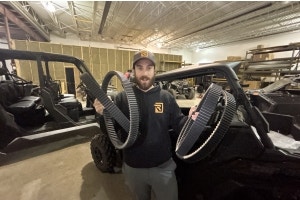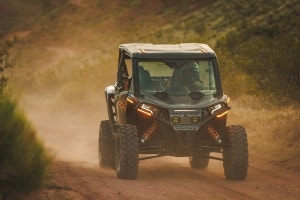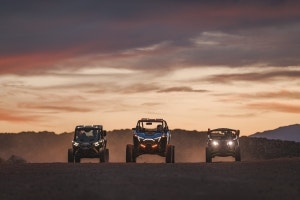UTV Belts: Pros, Cons, and DCT Systems

We’re here to talk belts, and not that kind that prevents your pants from falling down and showing off your tighty whiteys…
When it comes to side-by-sides (SxS), one of the hottest debates on the trail isn’t about which cooler holds the most snacks (though we’ll save that for another day). It’s about transmissions: belt-driven CVTs versus no-belt systems like Honda’s DCT. If you’re trying to decide which setup is best for your next UTV, you’ve come to the right place. We’ve got all the information but won’t be trying to sell you any belts or machines here.
The Belts: CVT Systems
Most SxS vehicles rely on a Continuously Variable Transmission (CVT) system with a rubber belt that’s responsible for transferring power from the engine to the wheels. Think of it as the middleman of your drivetrain—but one that occasionally likes to remind you it’s there with some drama.
Pros of Belt-Driven Systems
- Smooth Power Delivery
The CVT automatically adjusts gear ratios, making acceleration feel seamless—smooth and consistent. - Simple Operation
No need to fiddle with gears or paddle shifters. Just gas it and go, whether you’re cruising trails or hauling firewood. - Affordable Repairs
When a belt does wear out, replacements are generally less expensive than fixing a gear-driven system. - Lightweight and Compact
CVTs take up less space and add less weight, improving overall performance.
Cons of Belt-Driven Systems
- Durability Issues
Belts don’t love high heat or heavy loads. Extended use in harsh conditions can leave you with a burnt rubber smell and downtime on the side of the trail swapping it out. - Regular Maintenance
You’ll need to inspect and replace belts periodically, which can be inconvenient during long rides. - Slippage
Belts can slip under heavy loads or extreme conditions, reducing performance when you need it most. Be especially careful when towing or if your machine has been submerged under water.
No Belts: Gear-Driven Transmissions (Like Honda’s DCT)
On the flip side, some SxS manufacturers, like Honda, have ditched the belt altogether in favor of gear-driven systems, such as Dual Clutch Transmissions (DCT). Instead of relying on a belt, these systems use clutches and gears for a direct connection to the wheels.
Pros of No-Belt Systems
- Built for Durability
No belts mean no snapping or melting under pressure. These systems handle heat, towing, and aggressive driving like a pro. - Direct Power Transfer
With no belt to slip, you’ll get maximum power to the ground, perfect for high-performance applications. - Low Maintenance
You don’t have to worry about checking or replacing belts. - Manual Control Options
Systems like Honda’s DCT often come with paddle shifters, giving you more control over shifting.
Cons of No-Belt Systems
- More Complex
Gear-driven systems are mechanically intricate. Repairs can be costly and time-consuming. - Higher Upfront Cost
SxS models with gear-driven systems typically cost more. - Weight
These systems are heavier, which can affect fuel efficiency. - Learning Curve
Manual options like paddle shifters require some familiarity.
Belt Maintenance and Driving Tips
Belt Maintenance
- Inspect Regularly
Check for cracks, glazing, or fraying after every few rides. Replace as needed. - Keep It Clean
Clean the clutch housing and belt area to prevent debris build-up. - Avoid Excessive Heat
Overheating shortens belt life. Take breaks during heavy use, especially when towing. - Carry a Spare
Always have a backup belt and tools for replacement (we keep a MOLLE bag in every machine with our spare belts and tools so that the belt stays dry and dust free) ;
Driving Tips for CVT Systems
- Smooth Acceleration
Avoid sudden throttle changes. - Use Low Gear for Heavy Loads
Reduce stress on the belt by using low gear when towing or climbing. - Avoid Submerging the Clutch Housing
Water and belts don’t mix.
DCT Maintenance and Driving Tips
DCT Maintenance
- Check Fluid Levels
Maintain proper transmission fluid levels. - Inspect Clutches
Check for wear and replace if necessary. - Keep Software Updated
Ensure electronic components are running the latest updates.
Driving Tips for DCT Systems
- Use Manual Mode for Control
Paddle shifters offer better control on technical terrain. - Avoid Riding the Clutch
Avoid holding the throttle halfway for extended periods. - Warm Up in Cold Weather
Let the transmission warm up before hard use.
Which Is Right for You?
- Go for a Belt-Driven CVT if...
You value affordability, simplicity, and ease of maintenance. - Choose a No-Belt System if...
You need durability and precision for heavy-duty or high-performance use.
Final Thoughts
Choosing between a belt-driven CVT and a no-belt system comes down to your riding style and priorities. With proper maintenance and smart driving, either option can keep your UTV performing at its best. And if you’re going with a belt, always pack a spare—it’s better to be prepared than to have your ride cut short.





